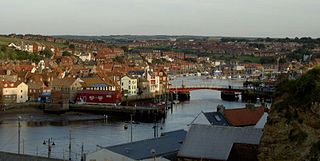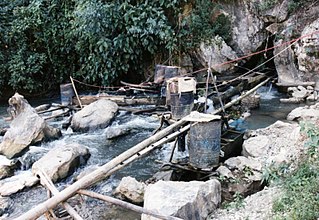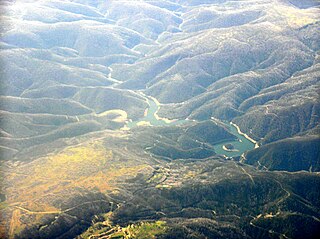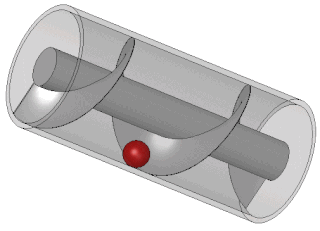
The Dinorwig Power Station, known locally as Electric Mountain, or Mynydd Gwefru, is a pumped-storage hydroelectric scheme, near Dinorwig, Llanberis in Snowdonia national park in Gwynedd, north Wales. The scheme can supply a maximum power of 1,728 MW (2,317,000 hp) and has a storage capacity of around 9.1 GWh (33 TJ).

The River Esk is a river in North Yorkshire, England that empties into the North Sea at Whitby after a course of around 28 miles (45 km) through the valley of Eskdale, named after the river itself. The river's name is derived from the Brythonic word "isca" meaning "water". The Esk is the only major river in Yorkshire that flows directly into the North Sea; all other watercourses defined as being major rivers by the Environment Agency, either flow to the North Sea via the River Tees or the Humber Estuary.

Micro hydro is a type of hydroelectric power that typically produces from 5 kW to 100 kW of electricity using the natural flow of water. Installations below 5 kW are called pico hydro. These installations can provide power to an isolated home or small community, or are sometimes connected to electric power networks, particularly where net metering is offered. There are many of these installations around the world, particularly in developing nations as they can provide an economical source of energy without the purchase of fuel. Micro hydro systems complement solar PV power systems because in many areas water flow, and thus available hydro power, is highest in the winter when solar energy is at a minimum. Micro hydro is frequently accomplished with a pelton wheel for high head, low flow water supply. The installation is often just a small dammed pool, at the top of a waterfall, with several hundred feet of pipe leading to a small generator housing. In low head sites, generally water wheels and Archimedes' screws are used.

The Tumut Hydroelectric Power Stations is a series of three hydroelectric power stations on the Tumut River in New South Wales, Australia, that are part of the Snowy Mountains Scheme.

Ruswarp village lies within the Scarborough borough of North Yorkshire, England. It is around 1.8 miles (2.9 km) from Whitby, at the junction of the B1410 and B1416 roads, on the River Esk and the Esk Valley Line, with trains stopping at Ruswarp railway station. Originally it was called Risewarp meaning 'silted land overgrown with brushwood'.

Briggswath is a village in the Scarborough district of North Yorkshire, England. the settlement is on the north bank of the River Esk, upstream of Ruswarp, and opposite Sleights which is on the south bank.

Torrs Hydro is a micro hydroelectric scheme, owned by the community, in New Mills, Derbyshire. It is located on the River Goyt, immediately after its confluence with the River Sett at the Torr weir. A 2.4-metre diameter steel trough screw turbine generates up to 63 kW of electricity.

Settle Hydro is a micro hydroelectric scheme, owned by the community, in Settle, North Yorkshire, England. It is located on the River Ribble, at Settle Weir near Bridge End Mill. It generates 50 kW of electricity using a screw turbine in part of the former mill race.

The Monmouth New Hydro Scheme, which incorporates the Osbaston fish pass, is a hydroelectric scheme in Osbaston, near Monmouth, in South-East Wales.

A screw turbine is water turbine that converts the potential energy of water on an upstream level into work. This hydropower converter is driven by the weight of water, similar to water wheels, and can be considered as a quasi-static pressure machine. Archimedes screw generators operate in a wide range of flows and heads, including low heads and moderate flow rates that are not ideal for traditional turbines and not occupied by high performance technologies.

The River Bain Hydro is a hydroelectric generator on the River Bain in the village of Bainbridge, North Yorkshire, England. Its screw turbine powers most of the properties in the village, with excess electricity being sold off to the National Grid. It was opened in 2011 with an installed capacity of 45 kW, and is expected to last 40 years. It is a low-demand ecofriendly scheme.

Burley Hydro Scheme, also known as Greenholme Mill Hydro is a micro hydroelectric scheme installed on the River Wharfe at Burley-in-Wharfedale, West Yorkshire, England. The power output of the hydro scheme is 330 kW with an annual output of 1,400 MWh and is the fourth hydro scheme on the river after the opening of similar power plants at Linton near Grassington, and two further downstream from Burley at Pool-in-Wharfedale and Garnett Wharfe at Otley. All of these schemes have been located on sites previously used to generate power from the water flow.

Ovenden Moor Wind Farm is a wind powered electricity generating site in England. Ovenden Moor is located north of Halifax and west of Bradford in West Yorkshire. The site was opened in 1993 with 23 turbines, but these were later removed in favour of larger turbines but with 14 fewer towers. This updated the output of the site from 9.2 MW to 22.5 MW with an expected generation lifetime of 25 years. As the turbines can be seen from some distance and the fact that they overlook the Brontë Country to the north, they have the subject of continued criticism and objections.

Linton Lock Hydro is a hydroelectric plant on the River Ouse in North Yorkshire, England, between the villages of Linton-on-Ouse and Nun Monkton. The first hydroelectric scheme was built here in 1923, but that was abandoned in the early 1960s. The second scheme to be sited at Linton Lock was installed in 2011 and a new generating unit came on stream in 2017. The combined output from the second and third generation plants is 380 kW, which is enough to power 450 homes.

Linton Falls Hydro is a hydroelectric generating power station located on the Linton Falls Weir of the River Wharfe, near Grassington, North Yorkshire, England. The power station is located on the same site as a hydroelectric scheme that was first opened in 1909, but had closed by 1948. The new scheme, which opened in March 2012, uses the original building which is now a scheduled monument.
Kirkthorpe hydro is a hydroelectric generating plant located on the River Calder at Kirkthorpe Weir, 4 miles (6.4 km) east of the City of Wakefield in West Yorkshire, England. The plant was opened in 2017 and expects to be generating electricity for 100 years. Kirkthorpe Weir is the highest industrial weir in Yorkshire and has prevented fish passing upstream to spawn; the new hydro project has a fish pass built into it.

Reading Hydro is a micro hydroelectric scheme in Reading, England. It is located on the River Thames, at the upstream end of View Island and using the head of water provided by the weir at Caversham Lock. With a drop of about 1.4 metres and an average water flow of 37 cubic metres (1,300 cu ft) per second, it can generate 46 kilowatts (62 hp) of electricity with its twin archimedes screw turbines.
Osney Lock Hydro is a micro hydroelectric scheme in Oxford, England. It is located on the River Thames, using the head of water provided by the weir at Osney Lock. It can generate 49 kilowatts (66 hp) of electricity with its archimedes screw turbine. Between 2015 and 2020 the scheme generated an average of 188 megawatt-hours (680 GJ) a year of electricity, which is enough to power around 60 homes.

Sandford Hydro is a small hydroelectric scheme located on the River Thames in Oxfordshire, England. It uses the head of water provided by the weir at Sandford Lock in Sandford-on-Thames, but is actually situated on the opposite bank of the river in Kennington. It can generate 450 kilowatts (600 hp) of electricity with its three archimedes screw turbines. Construction began in 2011, and the plant became operational in 2018.



















